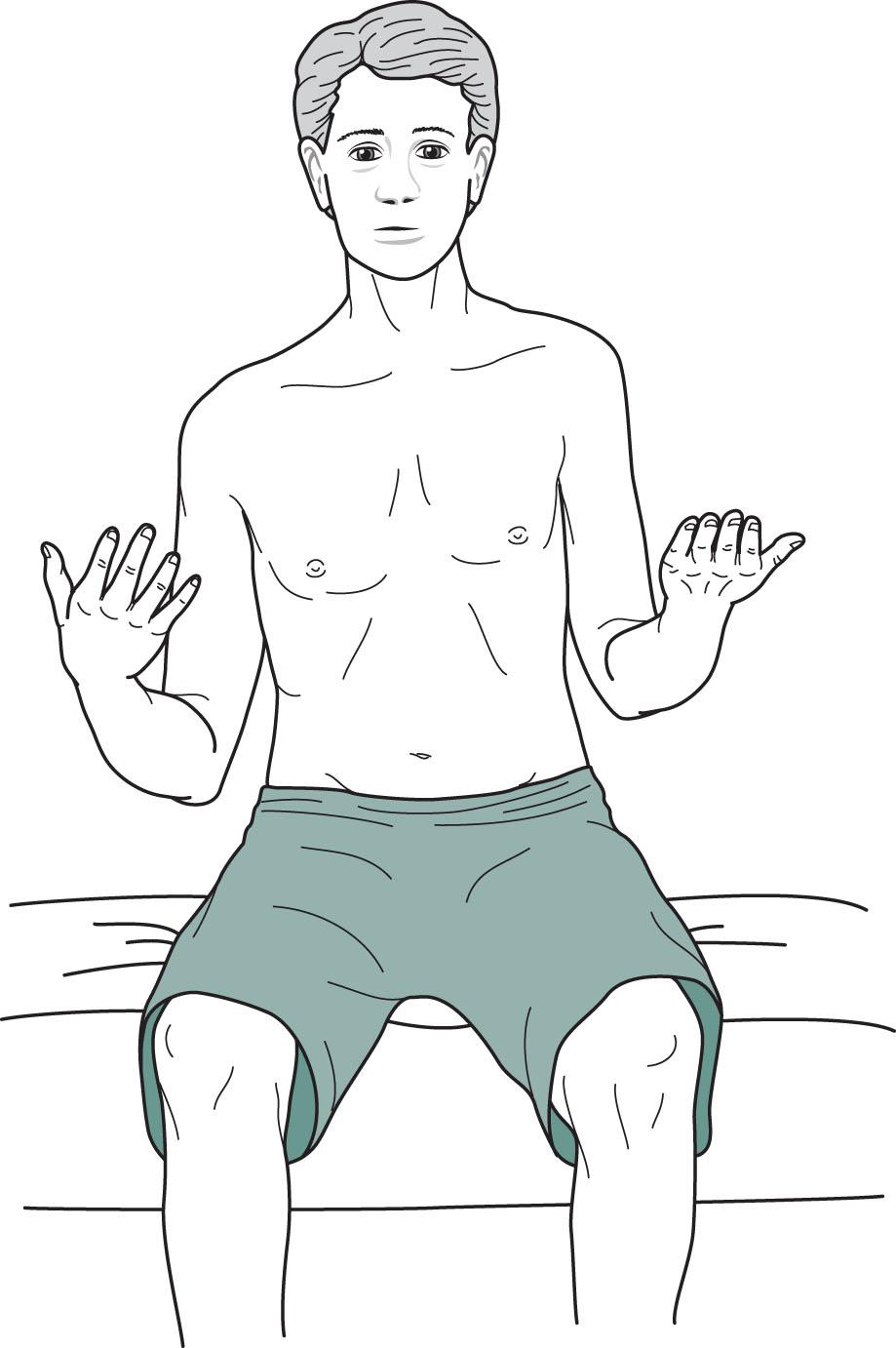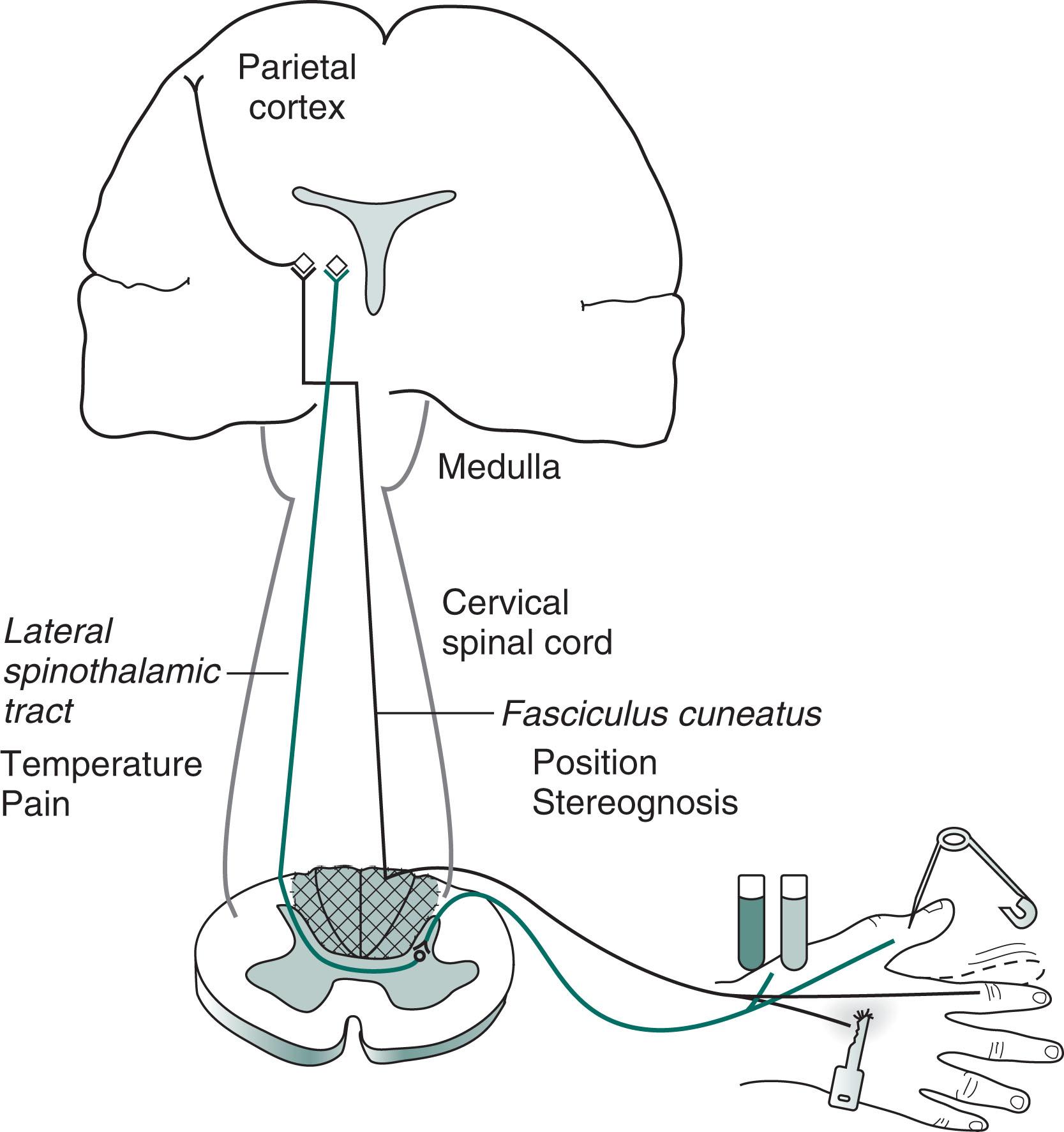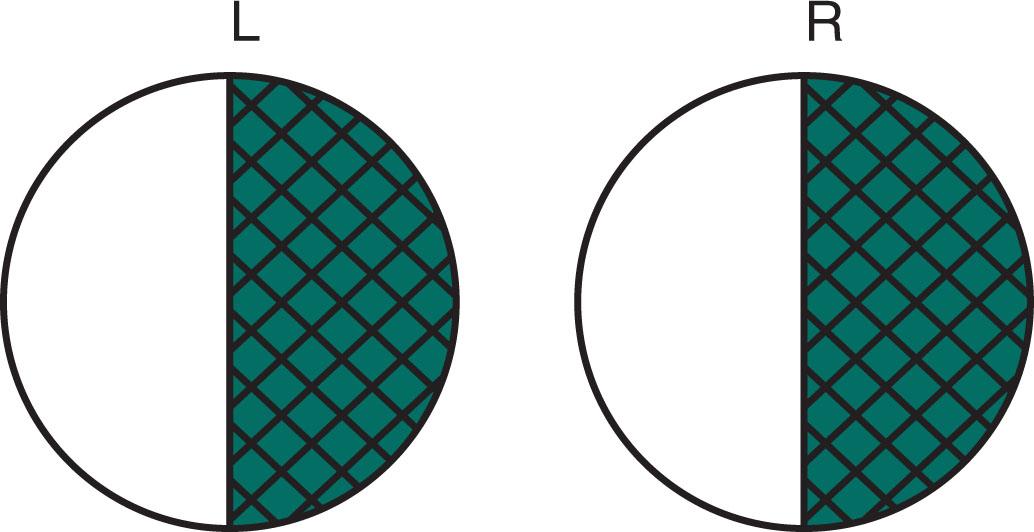Physical Address
304 North Cardinal St.
Dorchester Center, MA 02124
Disorders of the brain and the spinal cord—the two major components of the central nervous system (CNS)—typically cause readily recognizable combinations of paresis, sensory loss, visual deficits, and neuropsychologic disorders ( Box 2.1 ). Such signs of CNS disorders differ from those of peripheral nervous system (PNS), and both differ from the signs of psychogenic disorders. Neurologists formulate their preliminary diagnosis and often initiate treatment on the basis of the patient’s history and the examination, but if results of investigations—such as laboratory testing or magnetic resonance imaging (MRI)—contradict their diagnosis, they will usually revise it.
Cerebral hemisphere a
a Signs contralateral to lesions.
Hemiparesis with hyperactive deep tendon reflexes, spasticity, and Babinski sign
Hemisensory loss
Homonymous hemianopsia
Focal (partial) seizures
Aphasia, hemi-inattention, and dementia
Pseudobulbar palsy
Basal ganglia a
Movement disorders: parkinsonism, athetosis, chorea, and hemiballismus
Postural instability
Rigidity
Brainstem
Cranial nerve palsy with contralateral hemiparesis
Internuclear ophthalmoplegia (MLF b
b MLF , Medial longitudinal fasciculus.
syndrome)
Nystagmus
Bulbar palsy
Cerebellum
Spinal cord
Paraparesis or quadriparesis
Spasticity
Sensory loss up to a “level”
Bladder, bowel, and sexual dysfunction
Hemiparesis, usually accompanied by changes in reflexes and muscle tone, is one of neurology’s most prominent and reliable signs. Damage to the corticospinal tract , also called the pyramidal tract ( Fig. 2.1 ), in the cerebrum or brainstem rostral to (above) the decussation of the pyramids, causes contralateral hemiparesis ( Box 2.2 ) with weakness of the arm and leg—and, if the lesion is rostral enough, the lower face—opposite the side of the lesion. Damage to this tract within the spinal cord causes ipsilateral arm and leg or only leg paresis, but no facial weakness.

Either hemisphere a
a Signs contralateral to lesions.
Hemiparesis with hyperactive deep tendon reflexes and a Babinski sign
Hemisensory loss
Homonymous hemianopsia
Focal seizure
Dominant hemisphere
Aphasia: fluent, nonfluent, conduction, or isolation
Gerstmann syndrome: acalculia, agraphia, finger agnosia, and left–right confusion
Alexia without agraphia
Nondominant hemisphere
Hemi-inattention
Anosognosia
Constructional apraxia
Both hemispheres
Dementia
Pseudobulbar palsy
The division of the motor system into upper and lower motor neurons is a basic construct of clinical neurology. The corticospinal tract’s entire path from the cerebral cortex to the motor cranial nerve nuclei and the anterior horn cells of the spinal cord consists of upper motor neurons (UMNs) ( Fig. 2.2 ). The anterior horns contain the cell bodies of the lower motor neurons (LMNs) and hence are part of the PNS.

Cerebral lesions that damage the corticospinal tract cause signs of UMN injury (see Figs. 2.2–2.5 ):
Paresis with muscle spasticity
Hyperactive deep tendon reflexes (DTRs)
Babinski signs



In contrast, PNS lesions, including motor neuron diseases (diseases of the anterior horn cells) and disorders of nerves (neuropathy), cause signs of LMN injury:
Paresis with muscle flaccidity and atrophy
Hypoactive DTRs
No Babinski signs
Another indication of a cerebral lesion is loss of certain sensory modalities over one half of the body, that is, hemisensory loss ( Fig. 2.6 ). A patient with a cerebral lesion characteristically loses contralateral position sensation, two-point discrimination, and the ability to identify objects by touch (stereognosis). Neurologists often describe loss of those modalities as “cortical” sensory loss.

Pain sensation, a “primary” sense, is initially carried to the thalamus, after which it is projected rostrally to the cortex, limbic system, and elsewhere. Because the thalamus is situated above the brainstem but below the cerebral cortex, most patients with cerebral lesions still perceive painful stimuli. For example, patients with cerebral infarctions may be unable to specify a painful area of their body, but they will still feel the pain’s intensity and discomfort (see Chapter 14 ).
Visual loss of the same half-field in each eye, homonymous hemianopsia ( Fig. 2.7 ), is a characteristic sign of a contralateral cerebral lesion. Other equally characteristic visual field deficits are associated with lesions involving the eye, optic nerve, or optic tract (see Chapter 4, Chapter 12 ). Lesions in the brainstem, cerebellum, or spinal cord, because they are situated far from the visual pathway, do not cause visual field loss.

Another sign of a cerebral hemisphere lesion is a seizure (see Chapter 10 ). In fact, most focal seizures that alter awareness or induce psychomotor phenomena originate in the temporal lobe.
Although hemiparesis, hemisensory loss, homonymous hemianopsia, and focal seizures may result from lesions of either cerebral hemisphere, several neuropsychologic deficits are related to either the dominant or nondominant hemisphere. Neurologists usually ask a patient’s handedness when taking a history, but if this information is unavailable, because approximately 85% of people are right-handed, they assume that the left hemisphere is dominant.
Lesions of the dominant hemisphere may cause language impairment, aphasia , a prominent and frequently occurring neuropsychologic deficit (see Chapter 8 ). Because the corticospinal tract sits adjacent to the language centers, right hemiparesis often accompanies aphasia (see Fig. 8.1 ).
Lesions of the nondominant parietal lobe tend to produce one or more striking neuropsychologic disturbances (see Chapter 8 ). For example, patients may neglect or ignore left-sided visual and tactile stimuli (hemi-inattention) . They may fail to use their left arm and leg because they neglect their limbs rather than because of paresis. When they have left hemiparesis, patients may not appreciate it (anosognosia) . Many patients with nondominant lesions lose their ability to arrange matchsticks into certain patterns or copy simple forms ( constructional apraxia , Fig. 2.8 ).

As opposed to signs resulting from unilateral cerebral hemisphere damage, bilateral cerebral hemisphere damage produces several important disturbances that psychiatrists are likely to encounter in their patients. One of them, pseudobulbar palsy , best known for producing emotional lability, results from bilateral corticobulbar tract damage (see Chapter 4 ). The corticobulbar tract, like its counterpart, the corticospinal tract, originates in the motor cortex of the posterior portion of the frontal lobe. It innervates the brainstem motor nuclei, which in turn innervate the head and neck muscles. Traumatic brain injury (TBI), multiple cerebral infarctions (strokes), multiple sclerosis (MS), and neurodegenerative conditions, including frontotemporal dementia (see Chapter 7 ), are apt to strike the corticobulbar tract along with the surrounding frontal lobes and thereby cause pseudobulbar palsy.
Damage of both cerebral hemispheres—from large or multiple discrete lesions, degenerative diseases, or metabolic abnormalities—also causes dementia (see Chapter 7 ). In addition, because CNS damage that causes dementia must be extensive and severe, it usually also produces at least subtle physical neurologic findings, such as hyperactive DTRs, Babinski signs, mild gait impairment, and frontal lobe release reflexes. However, many neurodegenerative illnesses that cause dementia, particularly Alzheimer disease, do not cause “hard” findings such as hemiparesis.
While certainly not peculiar to cerebral lesions, and even typically absent in early Alzheimer disease, gait impairment is a crucial neurologic finding. Because walking requires intact and well-integrated strength, sensation, and coordination, testing the patient’s gait is the single most reliable assessment of a patient’s noncognitive neurologic function. Gait impairment constitutes the primary physical component of the subcortical dementias, such as vascular dementia, dementia with Lewy body disease, and Parkinson disease dementia (see Chapter 7 ). Several distinct gait abnormalities are clues to specific neurologic disorders, such as normal pressure hydrocephalus (see Table 2.1 ). As a general rule, slow gait speed, that is, 0.7 m/s, is associated with an increased risk of dementia, stroke, falls, disability, hospitalization, and death.
| Gait | Associated Illness | Figure |
|---|---|---|
| Apraxic | Normal pressure hydrocephalus | 7.10 |
| Astasia-Abasia | Psychogenic disorders | 3.4 |
| Ataxic | Cerebellar damage | 2.13 |
| Festinating (marche à petits pas) | Parkinson disease | 18.9 |
| Hemiparetic/hemiplegic | Strokes, trauma, congenital cerebral injury | |
| Circumduction | 2.4 | |
| Spastic hemiparesis | 13.4 | |
| Diplegic | Congenital injury | 13.3 |
| Steppage | Tabes dorsalis | 2.20 |
| Peripheral neuropathies | ||
| Waddling | Duchenne dystrophy and other myopathies | 6.4 |
Become a Clinical Tree membership for Full access and enjoy Unlimited articles
If you are a member. Log in here